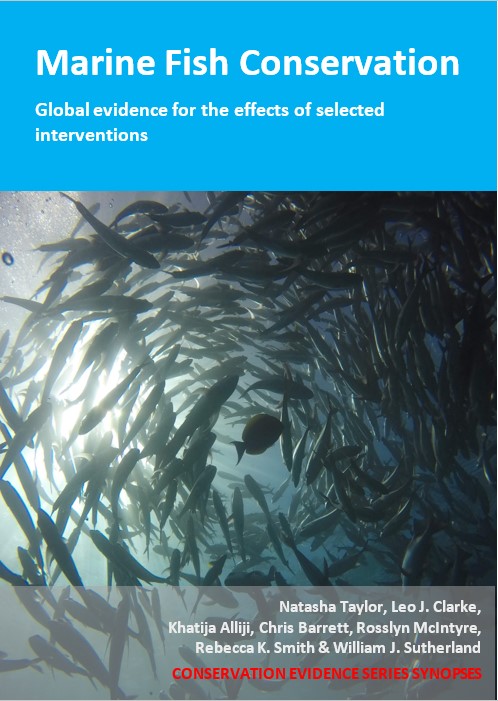Actions to conserve biodiversity
We have summarised evidence from the scientific literature about the effects of actions to conserve wildlife and ecosystems.
Review the evidence from the studies
Not sure what Actions are? Read a brief description.
Search for evidence
e.g. "frogs chytrid"
120 Actions found
Refine
Hide
120 Actions found
Download Actions
| 0 selected |
|
Order results by:
| Action | Effectiveness | Studies | Category | |
|---|---|---|---|---|
|
Use a different design or configuration of size-sorting escape grid/system in trawl fishing gear (bottom and mid-water) Action Link |
Awaiting assessment | 23 |
|
|
|
Use a different hook type Action Link |
Awaiting assessment | 25 |
|
|
|
Use a different method to sort or bring catch onboard Action Link |
Awaiting assessment | 0 |
|
|
|
Use a different twine type in a trawl net Action Link |
Awaiting assessment | 5 |
|
|
|
Use a larger mesh size Action Link |
Awaiting assessment | 42 |
|
|
|
Use a separator trawl Action Link |
Awaiting assessment | 2 |
|
|
|
Use a square mesh instead of a diamond mesh codend in a trawl net Action Link |
Awaiting assessment | 26 |
|
|
|
Use a topless (coverless) trawl Action Link |
Awaiting assessment | 4 |
|
|
|
Use an alternative commercial fishing method Action Link |
Awaiting assessment | 9 |
|
|
|
Use an alternative method to commercially harvest plankton Action Link |
Awaiting assessment | 1 |
|
|
|
Use an electric (pulse) trawl Action Link |
Awaiting assessment | 3 |
|
|
|
Use artificial light on fishing gear Action Link |
Awaiting assessment | 2 |
|
|
|
Use citizen surveillance to report illegal fishing Action Link |
Awaiting assessment | 0 |
|
|
|
Use flags to signal the legal nationality of a fishing vessel Action Link |
Awaiting assessment | 0 |
|
|
|
Use hook and line fishing instead of other commercial fishing methods Action Link |
Awaiting assessment | 3 |
|
|
|
Use human observers onboard fishing vessels to monitor catches and discards Action Link |
Awaiting assessment | 0 |
|
|
|
Use methods to trace the source of catch Action Link |
Awaiting assessment | 0 |
|
|
|
Use netting of contrasting colour in a trawl net Action Link |
Awaiting assessment | 1 |
|
|
|
Use onboard CCTV for monitoring catches and discards Action Link |
Awaiting assessment | 0 |
|
|
|
Use technology to communicate near real-time catch information to fishers to enable avoidance of unwanted catchicate near real-time catch information to fishers to enable avoidance of unwanted catch Action Link |
Awaiting assessment | 1 |
|
Download Actions
| 0 selected |
|

Marine Fish Conservation - Published 2021
Watch this search
If you are familiar with RSS feeds, please click the button below to retrieve the feed URL:
RSS feed for this searchIf you are unfamiliar with RSS feeds, we would suggest reading this BBC article.
Unfortunately, due to the number of feeds we have available, we cannot provide e-mail updates. However, you could use tools such as Feed My Inbox to do this for you.
What are 'Individual studies' and 'Actions'?
Individual studies
An individual study is a summary of a specific scientific study, usually taken from a scientific journal, but also from other resources such as reports. It tells you the background context, the action(s) taken and their consequences.
If you want more detail please look at the original reference.
Actions
Each action page focuses on a particular action you could take to benefit wildlife or ecosystems.
It contains brief (150-200 word) descriptions of relevant studies (context, action(s) taken and their consequences) and one or more key messages.
Key messages show the extent and main conclusions of the available evidence. Using links within key messages, you can look at the paragraphs describing each study to get more detail. Each paragraph allows you to assess the quality of the evidence and how relevant it is to your situation.
Where we found no evidence, we have been unable to assess whether or not an intervention is effective or has any harmful impacts.





)_2023.JPG)














